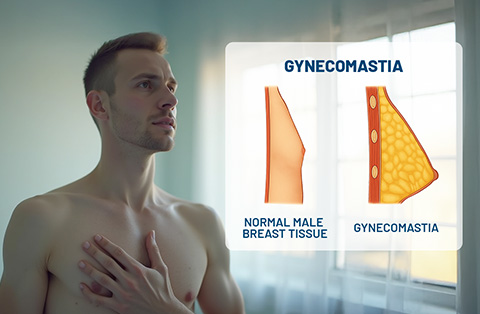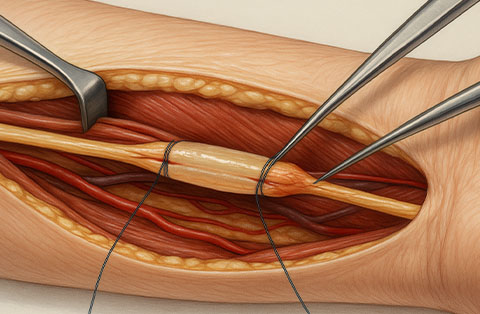Struggling with persistent forearm pain near your elbow? Learn how to identify, treat, and recover from radial tunnel syndrome before it affects your strength and daily function.
Radial tunnel syndrome is a condition where the radial nerve gets compressed as it passes through a narrow space in the forearm, causing pain, weakness, or fatigue in the arm.
While often mistaken for tennis elbow, radial tunnel syndrome requires a different approach to diagnosis and treatment. It’s a relatively uncommon condition, but when untreated, it can interfere with daily tasks like gripping, lifting, or using tools. Repetitive arm movements in work or sports are common triggers.
This article explains what radial tunnel syndrome is, what causes it, how to recognize the symptoms, and which treatment options can help relieve pain and restore function.
What is radial tunnel syndrome?
Radial tunnel syndrome is a nerve compression disorder. It occurs when the radial nerve is compressed or irritated in the radial tunnel, a narrow space in the upper forearm near the elbow.
When structures in or around the tunnel apply pressure to the radial nerve it can cause pain, weakness, or discomfort in the forearm and wrist. This condition is known as radial tunnel syndrome.
What is radial tunnel?
The radial nerve runs from the neck down the back of the arm and into the hand. In the forearm, it travels through a muscular channel called the radial tunnel, located near the elbow joint. This tunnel is formed by muscles, tendons, and bone.
What causes radial tunnel syndrome?
Radial tunnel syndrome is caused by compression or irritation of the radial nerve as it passes through the radial tunnel in the upper forearm. Several anatomical structures and activities can contribute to this compression.
Common causes:
Repetitive forearm movements: Frequent rotation of the forearm, especially twisting motions (like using a screwdriver), can irritate or compress the radial nerve.
Forceful wrist and finger extension: Repeated or sustained extension movements increase tension on the radial nerve and nearby tendons.
Muscle hypertrophy: Enlarged or overused muscles in the forearm can put pressure on the nerve.
Fibrous bands or tight tissue: Tight fascia or fibrotic bands within the radial tunnel can constrict the nerve.
Direct trauma: A blow to the outer forearm or repeated minor trauma can inflame tissues around the nerve.
Compression by adjacent structures: The radial nerve may be compressed where it passes between the two layers of the supinator muscle, particularly in the area known as the arcade of Frohse, a common site of entrapment.
Occupational and sports-related activities that involve forceful, repetitive use of the elbow, forearm, or wrist can increase the risk of developing radial tunnel syndrome. In some cases, no clear cause is identified, but mechanical overuse is the most frequent contributing factor.
What are the signs and symptoms of radial tunnel syndrome?
Radial tunnel syndrome causes a set of symptoms related to radial nerve compression in the upper forearm. These symptoms are often mild at first and may worsen with continued activity or pressure on the nerve.
Common signs and symptoms include:
Aching pain in the outer forearm: This is the most frequent complaint. Pain is usually felt a few centimeters below the lateral epicondyle (the bony part on the outer elbow) and can radiate down the forearm.
Pain with forearm activity: Actions like gripping, pushing, pulling, or rotating the forearm (e.g., turning a doorknob or screwdriver) can trigger or worsen pain.
Tenderness over the radial tunnel: Pressing on the area just below the elbow often causes discomfort.
Weakness in wrist or finger extension: In some cases, if the posterior interosseous nerve is affected, patients may notice reduced strength when extending the wrist or fingers.
Fatigue in the forearm: The arm may tire quickly during repetitive tasks, even without sharp pain.
No sensory loss: Although the radial nerve has sensory functions, numbness and tingling are typically absent. This helps differentiate radial tunnel syndrome from other nerve conditions.
Pain from radial tunnel syndrome is often mistaken for tennis elbow, but it typically occurs slightly farther down the forearm and is caused by nerve irritation rather than tendon inflammation.
How does radial tunnel syndrome differ from tennis elbow?
Radial tunnel syndrome involves compression of the radial nerve, causing deep, aching pain in the outer forearm, often without tenderness at the elbow. In contrast, tennis elbow (lateral epicondylitis) is caused by tendon overuse, leading to sharp pain directly at the lateral epicondyle. Radial tunnel pain is typically lower on the arm and worsens with nerve compression, while tennis elbow pain worsens with resisted wrist extension.
How is the diagnosis of radial tunnel syndrome?
The diagnosis of radial tunnel syndrome is primarily clinical, based on the patient’s history, symptoms, and a detailed physical examination. Since there is no single definitive test, diagnosis often involves ruling out other causes of forearm and elbow pain, such as tennis elbow or cervical nerve root compression.
What does a physical examination for radial tunnel syndrome involve?
A clinician will assess for:
Tenderness over the radial tunnel, typically 3–5 cm below the lateral epicondyle.
Pain with resisted forearm supination (turning the palm upward) or resisted middle finger extension—these tests put stress on the radial tunnel.
No significant tenderness at the lateral epicondyle, which helps distinguish it from tennis elbow.
No sensory loss, which differentiates it from other nerve entrapments.
What tests help confirm radial tunnel syndrome?
While the physical exam is key, some tests may be used to support the diagnosis:
Nerve conduction studies (NCS) and electromyography (EMG) can detect radial nerve dysfunction, especially in cases involving the posterior interosseous nerve. However, these tests may appear normal if only sensory fibers are affected.
Imaging (MRI or ultrasound) is not routinely needed but may help exclude other conditions like tumors, masses, or structural abnormalities.
Diagnostic nerve block: Injection of a local anesthetic into the radial tunnel can temporarily relieve pain. If symptoms improve, this supports the diagnosis.
Because radial tunnel syndrome shares symptoms with other conditions, an accurate diagnosis requires a careful combination of clinical findings and diagnostic exclusion.
How are the radial tunnel syndrome treatments?
Radial tunnel syndrome treatment focuses on relieving pressure on the radial nerve, reducing pain, and restoring arm function. The approach typically begins with non-surgical treatment options, reserving surgery for cases that don’t improve after several months.
What non-surgical treatment options are available for radial tunnel syndrome?
Most patients respond well to conservative care, especially when treatment begins early. Common non-surgical treatments include:
Activity modification: Avoiding repetitive forearm motions or forceful wrist extension that aggravate symptoms.
Rest and splinting: Using a wrist or elbow splint to limit movement and reduce nerve irritation.
Anti-inflammatory medications: NSAIDs can help reduce inflammation and relieve pain.
Physical therapy: A structured program focusing on stretching, nerve gliding exercises, and gradual strengthening of the forearm muscles.
Ergonomic adjustments: Modifying workstations or tool use to reduce stress on the radial tunnel.
Corticosteroid injections: Although controversial, some clinicians use targeted injections near the radial tunnel for short-term pain relief.
When is surgical treatment needed for radial tunnel syndrome?
If symptoms persist for 3 to 6 months despite conservative treatment, surgical treatment may be considered. Surgery involves decompression of the radial tunnel, usually by releasing fibrous bands or the supinator muscle compressing the nerve.
Surgical outcomes are generally favorable, but recovery can take several months, and physical therapy is often needed postoperatively. Surgery is typically reserved for patients with persistent pain or those with documented posterior interosseous nerve involvement.
Overall, most people recover with non-surgical treatment, especially when diagnosed early and properly managed.
What are the surgical options for radial tunnel syndrome?
When non-surgical treatments fail to relieve symptoms after several months, surgical treatment may be recommended to decompress the radial nerve within the radial tunnel. The goal is to release pressure on the nerve and prevent further irritation.
The main surgical options include:
Radial tunnel decompression: This is the most common procedure. It involves releasing tight structures in the tunnel, such as fibrous bands or the supinator muscle, especially near the arcade of Frohse—a frequent site of nerve compression.
Posterior interosseous nerve (PIN) release: If the posterior interosseous nerve, a branch of the radial nerve, is also compressed, surgeons may extend the release to this area. This is done when motor weakness (not just pain) is present.
Endoscopic release (less common): Some surgeons may use a minimally invasive technique to reduce tissue damage and promote faster recovery. However, this approach is less widely used and depends on the surgeon's experience.
What outcomes can patients expect after surgery?
The procedure is typically outpatient and performed under regional or general anesthesia.
Recovery includes temporary activity restriction followed by physical therapy to restore strength and range of motion.
Most patients report pain relief within weeks, but full recovery may take several months.
Surgery is usually effective, especially in patients with well-documented nerve compression. However, outcomes are best when the diagnosis is accurate and conservative treatment has already been attempted.
How can radial tunnel syndrome be prevented or avoided?
While not all cases of radial tunnel syndrome can be prevented, especially those linked to anatomical variations, many can be avoided by minimizing repetitive stress on the radial nerve and maintaining healthy movement patterns in the elbow and forearm.
Avoid repetitive forearm rotation: Repeated pronation and supination (twisting motions) increase pressure within the radial tunnel. Alternate tasks when possible to reduce strain.
Use proper ergonomics: At workstations or during manual labor, keep the wrist in a neutral position and avoid prolonged extension or gripping.
Modify tools and equipment: Use ergonomically designed tools that reduce wrist strain and allow a natural grip.
Strengthen and stretch forearm muscles: Regular exercises improve flexibility and reduce the risk of overuse injuries that can lead to nerve compression.
Take frequent breaks: If your work or sport involves repeated arm movements, short rest periods can prevent muscle fatigue and irritation around the radial nerve.
Address early symptoms: Seek evaluation if you develop persistent forearm pain or weakness. Early intervention can prevent progression to full nerve entrapment.
These steps are especially important for people in high-risk groups, such as manual laborers, mechanics, and athletes in racquet or throwing sports. Preventive care and awareness can reduce the likelihood of developing this chronic nerve condition.





